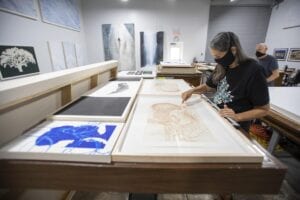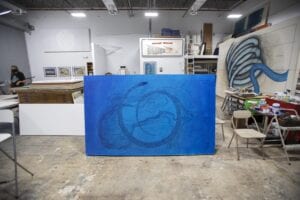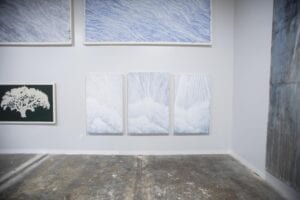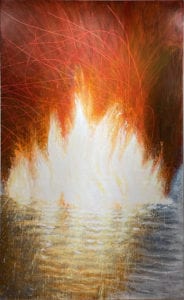June 22, 2020
Tuesday, June 30, 7-9 pm
Facebook Live

Collaborators Carol Mickett and Robert Stackhouse create artworks that investigate the structures of the world around us. Mickett, who has a Ph.D. in philosophy from the University of Minnesota, analyzes the concepts conveyed by their work. Stackhouse, who has an Honorary Doctorate from the University of South Florida and an M.A. from the University of Maryland, finds materials to use. The results of their artistic collaboration include drawings, paintings, prints and architectural installations on view in public and private spaces.
Tom Winchester: Can you describe your creative process?
Carol Mickett: We both have ideas about how things should go. The beginning part of an idea involves finding our footing with each other. I’m somebody who, because of my background, I’m much more about moving around a creative landscape of ideas. Robert is like a dog with a bone, and he holds on to it. So, in the beginning stages of an idea, he has to hone me in, and I have to make him give up the bone. And then we find where we’re going.
Robert Stackhouse: Quite often, too quickly, I examine how we’re going to make the thing. That’s my first instinct. ‘What’s the challenge in making it?’

TW: Carol, how does your background in philosophy influence your contribution to the collaboration?
CM: I think it influences my focus on the conceptual elements of our work. I am always asking how does an idea fit in, conceptually, with what we’ve been doing. I was trained as an analytic philosopher, so I’m trained to think through things, to find the counter example, to find what’s wrong with it.
I assume everything’s right, but could be better. My training allows me to be a process person, and Robert’s a process person. That’s why we can work together. We don’t, for example, have an idea of what a work’s going to be, and then do it exactly as planned. We allow the process to move us in different directions.
TW: Who are the artists that inspire the two of you?
CM: Louise Nevelson. I saw her when I was an undergraduate, and she was so powerful. Her work is so structural, ordered and logical. I love that sense of order. She’s very important to me also because she’s a woman. When I was young, there weren’t very many women artists who had such prominence. She had this whole air about her.
RS: I think of Mark Rothko. When I was an undergraduate student, I was told I didn’t know how to use color. I’d gone through graduate school making acrylic paintings that looked like every other graduate student’s acrylic paintings. I had no real interest in using colors. My use of color hadn’t evolved until I got in to watercolor. But now, what I love about that painting of a serpent is that blue. Rothko understood the power of color, and the depth of color.

Another inspiration is Alberto Giacometti. My first experience with Giacometti was in the late ‘60s, in a gallery in uptown New York City. When a few friends and I were exiting the gallery, a friend of mine asked, ‘What did you think of the Giacometti?’ I responded, ‘What Giacometti? I didn’t see it.’ He said, ‘How could you miss it? It was seven-feet tall!’
That experience has had lasting impact on me. I’ve done a number of sculptures that were very obviously inspired by it, including Sleeping King Ascending (1973), my first sculpture for a major museum. That piece was a 40-feet long, 20-feel tall truncated pyramid going out of a skylight at the Corcoran Gallery of Art in Washington DC. But it was only four-inches thick. So, as you came up the main staircase, in to the second floor atrium of gallery, you didn’t see it. That piece was a direct result of having not seen the Giacometti.
And, of course, I’ve always immediately gone to Leonardo DaVinci, just because of his Codex. I’m in awe of a person that could be so curious, and so uninhibited about that curiosity. We refer to that Codex a lot, especially his study of water.
TW: Much of your work depicts water.

CM: Water has a structure, and our work has a lot to do with structure. This triptych – Structure of Mist (2015), Structure of Cresting Water (2015) and Structure of Clear Water (2015) – depicts a structure coming out of the mist. What is often thought of as not having a structure, especially a mist of water, actually does. We’re inspired, in part, by the statement by the philosopher, Thales, ‘Everything is water.’
RS: We’re also inspired by the idea that, ‘You can’t step into the same river twice.’ It’s a very interesting concept for art, and an artist could spend the rest of their life trying to make an artwork of that idea.
TW: Carol, you and Robert will be doing a Facebook Live interview for Creative Pinellas on June 30. Can you tell us about that?
CM: Our first topic will be Having a Place. Our guests are Terri Lipsey Scott, who is the executive director of the Dr. Carter G. Woodson African American Museum — they are in the process of building a new museum — and Nick Davis, an artist who makes digital portraits.

TW: You are Artist Laureates for Creative Pinellas. What are your plans for that grant?
RS: We’re proposing to do a wall-to-wall, floor-to-ceiling installation based on the current lines in our painting titled, T / Here (2008).
If you can imagine those current lines being a proscenium. It would be a standalone installation and would have reference to the currents of the Earth, and how everything is connected.
In addition, we would like to invite dancers to dance in it, musicians to play music in it, and actors to perform plays in it—possibly scenes from Shakespeare’s A Midsummer Night’s Dream or The Tempest.
Find out more about
Mickett-Stackhouse Studio here
Photos by Tom Winchester

Carol Mickett and Robert Stackhouse are offering for sale one of their paintings, An Imbalance of Fire, from their climate change series. Fifty percent (50 %) of the sale will go to The Pinellas Arts Community Relief Fund.
This Fund has been established to provide urgent financial support for Pinellas County artists, arts organizations and creative businesses with immediate needs in the face of the current COVID-19 emergency. The Fund’s goal is to ensure that the vibrant arts and cultural landscape of Pinellas County remains intact through this emergency and beyond.
Find out more here.




